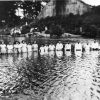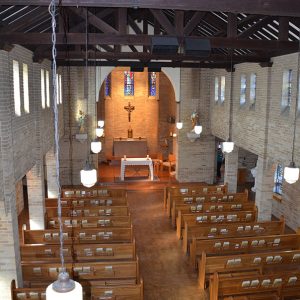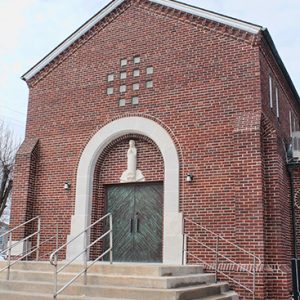calsfoundation@cals.org
St. Mary's Catholic Church (Paragould)
St. Mary’s Catholic Church in Paragould (Greene County) is a brick-and-steel structure designed by renowned architect Charles Eames and his architectural partner Robert Walsh in 1935.
Charles Eames was born and raised in St. Louis, Missouri, where he attended Washington University before opening an architecture firm with Charles Grey and Walter E. Pauley. After a solo trip to Mexico in 1933, Eames started a new firm with Robert Walsh in 1934. During the next few years, Eames and Walsh worked on several projects in and around St. Louis, as well as two Catholic churches in eastern Arkansas: one in what is now Helena-West Helena (Phillips County) and one in Paragould. Eames eventually gained an international reputation as an architect and designer after attending Cranbrook Academy of Art in the late 1930s and moving to California with his wife, designer Ray Eames.
St. Mary’s Catholic Church is located at the intersection of West Highland and North Second Street in the city’s historic downtown. The building was designed in a restrained Romanesque Revival style, with rounded arches above the windows and doors, as well as a large central bell tower along the east façade. The red brick of the exterior gives way to the exposed buff brick of the interior, which also features exposed wooden beams that support the roof structure. Arkansas marble from Batesville (Independence County) was used for the altar, front steps, and arch above the entry doors. The stained-glass windows in the church include Christian symbols such as the Greek Alpha and Omega symbols, loaves, fishes, crowns, and the Latin words “PAX” and “LUX.” The three large figural stained-glass windows were acquired from Munich, Germany, to complete the interior of the church.
The congregation of St. Mary’s in Paragould was established in December 1883 by Monsignor Eugene John Weibel, who conducted masses in the downtown Commercial Hotel. Soon, a new church was acquired by the congregation, with the first mass held inside in May 1890. This wood-framed structure would serve the congregation until the construction of a new brick-and-steel church in 1935.
The effort to raise money and organize for a new church building was led by the congregation’s longtime pastor, Father Joseph M. Hoflinger. Eames and Walsh submitted plans in September 1935, and the new church was under construction by the end of the year. Local volunteers helped construct the church in order to keep costs at a minimum. This included the students of the adjacent Catholic school, who hauled bricks to the site from the nearby train-yard.
The church was dedicated by Bishop John Morris of Little Rock (Pulaski County) in December 1936 in front of an overflow crowd of nearly 600. Although this church is similar in construction to St. Mary’s Catholic Church in Helena, the limited budget of the Paragould congregation led to a smaller building with less detail than seen in the Helena church.
St. Mary’s Catholic Church in Paragould was listed in the National Register of Historic Places on January 27, 2015, and continues to serve the local Catholic community in the twenty-first century.
For additional information:
Kirkham, Pat. Charles and Ray Eames: Designers of the Twentieth Century. Cambridge, MA: MIT Press, 1995.
Williams, Callie. “Arkansas Listings in the National Register of Historic Places: ‘Some Oddball Churches’: Charles Eames in Arkansas.” Arkansas Historical Quarterly 76 (Winter 2017): 375–383.
———. “St. Mary’s Catholic Church.” National Register of Historic Places registration form. 2015. On file at Arkansas Historic Preservation Program, Little Rock, Arkansas. Online at https://www.arkansasheritage.com/arkansas-historic-preservation-program (accessed December 19, 2023).
Zakrzewski, Katie. “Architect Honors Eames, Designer of 2 Arkansas Parishes.” Arkansas Catholic, December 18, 2023. https://www.arkansas-catholic.org/news/article/8073/Architect-honors-Eames-designer-of-2-Arkansas-parishes (accessed December 19, 2023).
Callie Williams
Arkansas Historic Preservation Program
 Early Twentieth Century, 1901 through 1940
Early Twentieth Century, 1901 through 1940 Historic Preservation
Historic Preservation Religion
Religion St. Mary's Catholic Church Interior
St. Mary's Catholic Church Interior  St. Mary's Catholic Church
St. Mary's Catholic Church 




Comments
No comments on this entry yet.